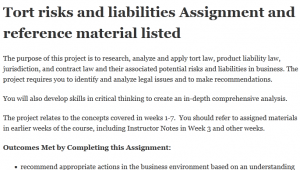Tort risks and liabilities Assignment and reference material listed

The purpose of this project is to research, analyze and apply tort law, product liability law, jurisdiction, and contract law and their associated potential risks and liabilities in business. The project requires you to identify and analyze legal issues and to make recommendations.
You will also develop skills in critical thinking to create an in-depth comprehensive analysis.
The project relates to the concepts covered in weeks 1-7. You should refer to assigned materials in earlier weeks of the course, including Instructor Notes in Week 3 and other weeks.
Outcomes Met by Completing this Assignment:
- recommend appropriate actions in the business environment based on an understanding of sources of law, legal process and procedure, and available remedies
- analyze contractual rights, obligations, liabilities, and remedies in the business environment
- analyze tort rights, obligations, liabilities, and remedies in the business environment
Background: Things are moving quickly for the GC owners. They are almost ready to open operations and finalize contract negotiations with EPI to purchase cleaning products. EPI and GC have already agreed that GC:
(1) will buy cleaning products exclusively from EPI for three years,
(2) will be permitted to resell those products to clients and other businesses, and
(3) may contract with certain businesses who buy cleaning products from GC to become Authorized Distributors (AD) for those GC products; ADs will be listed on GC’s website.
GC needs to draft a contract to reflect an agreement between GC and future ADs. The contract will be complex, and GC is concerned about risks and liabilities created by AD relationships.
In a meeting with TLG, GC owners stated they have heard about several recent lawsuits involving businesses and ADs. Connor presented a “what if…” scenario that could create complicated liabilities arising from GC-AD agreements.
The “what if…” scenario follows.
“What-If…” scenario: In contracts with ADs, GC includes an indemnification clause stating that the AD would cover claims by third parties harmed directly as a result of the ADs actions.
A GC AD contracts to clean concrete floors in a commercial building in North Carolina using Floor-ex, a cleaning solution, purchased from GC (manufactured by EPI and sold to GC for resale distribution).
The AD’s employee spills a large tub of Floor-ex on the job site resulting in the following:
- the building owner slips on the spill, is injured and misses 3 weeks of work;
- the building owner hits a piece of equipment in the fall causing it to slide resulting in damage;
- Floor-ex splashes on the wall, staining it and part of the wall must be replaced.
The building owner files a lawsuit against the AD and GC for negligence, as well as for product liability. The building owner seeks compensation damages for:
- medical expenses and economic loss from her injuries;
- costs for repair to the building wall;
- costs for repair to the damaged piece of equipment.
The GC owners ask TLG’s opinion about their liability if a situation like the “what-If…” scenario occurred with one of their ADs. TLG’s response will influence the owners’ final decision about whether to use ADs in their new business.
Instructions:
Winnie and Ralph asked you to discuss the “what-If…” scenarios and analyze the related potential liabilities with an attorney TLG has on retainer. Winnie and Ralph want you to then summarize the attorney’s analysis in a memorandum to them for further discussion with the GC owners.
The memo should analyze and explain:
Part I. Green Clean
1. The strengths of the plaintiff’s negligence claim against GC;
2. Potential defenses, if any, GC could assert in the negligence claim;
3. The strengths of the plaintiff’s product liability claim against GC;
4. Jurisdiction issues if GC was sued in North Carolina.
Part II. Authorized Distributor
5. The strengths of the plaintiff’s negligence claim against AD;
6. Potential defenses, if any, AD could assert in the negligence claim;
7. The strengths of the plaintiff’s product liability claim against AD;
8. Whether, if AD is found liable for negligence and for product liability, AD could sue GC to recover damages paid to the plaintiff?
Format
Label all parts.
Use correct, complete sentences, in paragraph format.
Use in-text citations and a Reference List in APA format.
Support and explain all conclusions.
Write an in-depth, comprehensive analysis.
Memorandum
To: Winnie James, Ralph Anders
From: (Your Name)
Date:
Re: Liability Analysis
Part I.
1.
2.
3.
4.
Part II.
5.
6.
7.
8.
__________
Review the Project Memorandum
Thoroughly read the project to ensure all required elements are present.
Proofread for spelling and grammatical issues.
Use the spell and grammar check in Word.